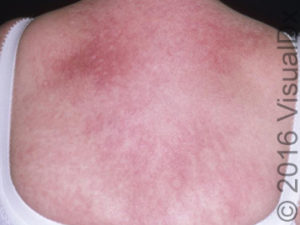Published on
The Resolution
Differential Diagnosis
- Systemic lupus erythematosus
- Polymorphous light eruption
- Allergic contact dermatitis
- Dermatomyositis

Diagnosis
This patient was diagnosed with dermatomyositis, a multisystem autoimmune connective tissue disease characterized most often by a symmetrical proximal extensor inflammatory myopathy; a characteristic violaceous cutaneous eruption; and pathogenic circulating antibodies.
Diagnosis is made through blood tests showing elevated levels of muscle enzymes. Further testing includes lung x-rays; electromyography; MRI; and skin or muscle biopsy.
Learnings/What to Look for
- While the etiology is unclear, some evidence suggests that genetically susceptible individuals with certain HLA types mount aberrant cellular and humoral responses after exposure to infection, malignancy, or drug ingestion
- Clinical features of dermatomyositis can be categorized into cutaneous and systemic manifestations
- Typical findings include a heliotrope rash, atrophic dermal papules of dermatomyositis (ADPDM, also known previously as Gottron’s papules), shawl sign, holster sign, photosensitivity, flagellate erythema, poikiloderma, calcinosis cutis and nail fold changes. Pruritus is also common
- Systemic manifestations of dermatomyositis include fatigue, malaise, and myalgias, as well as various musculoskeletal, gastrointestinal, pulmonary, and cardiological complaints
- Up to 40% of patients with adult dermatomyositis may have an occult malignancy
Pearls for Urgent Care Management and Transfer
- Treatment of dermatomyositis includes corticosteroids for the muscular component and avoiding exposure to the sun
- Immunomodulatory medications such as methotrexate, mycophenolate mofetil, or intravenous immunoglobulin may be used
- Refer to a rheumatologist
Acknowledgment: Images and case courtesy of VisualDx (www.VisualDx.com/JUCM).
A 51-Year-Old Woman with Multiple Dermatological Symptoms and Muscle Weakness
1 2
